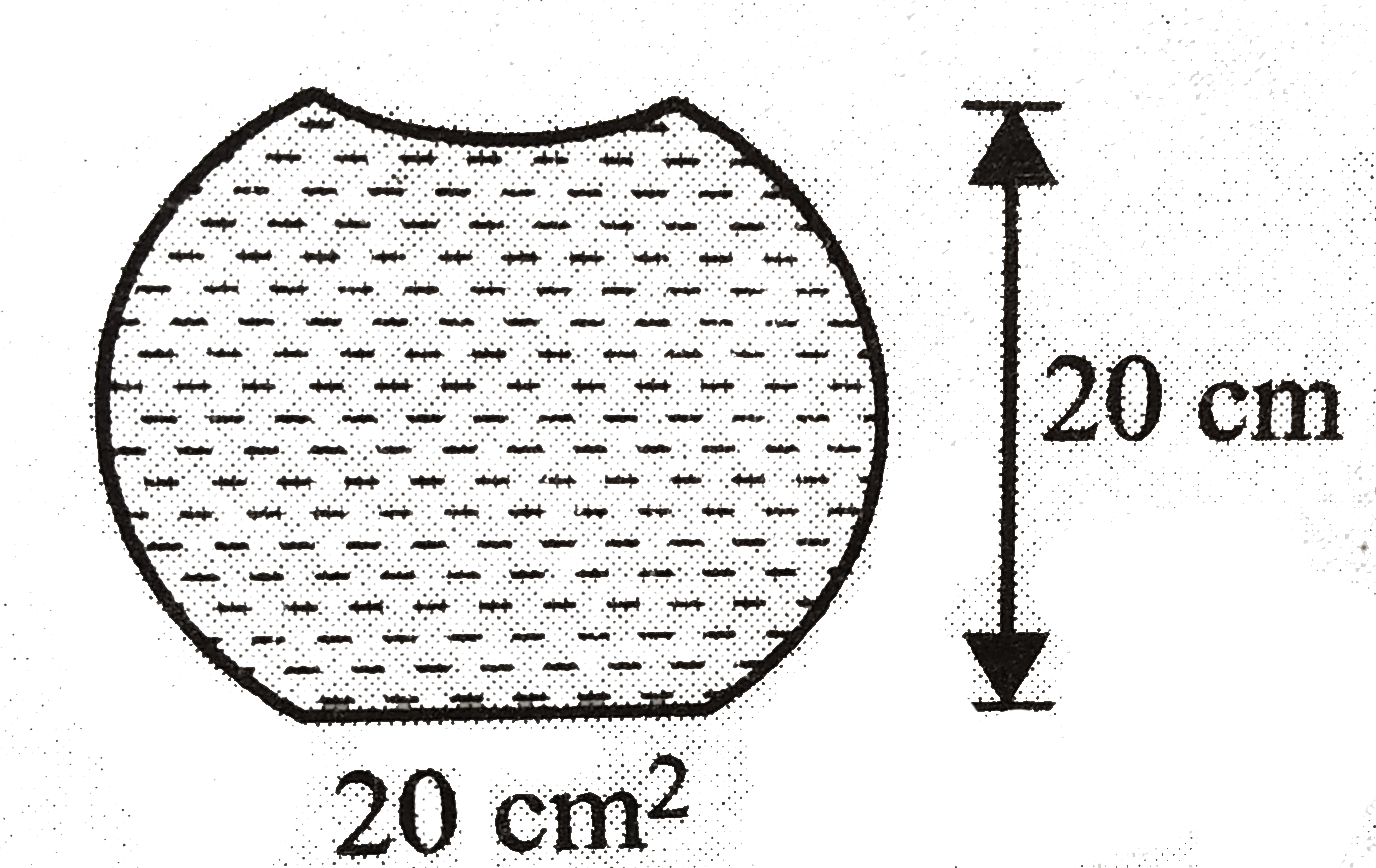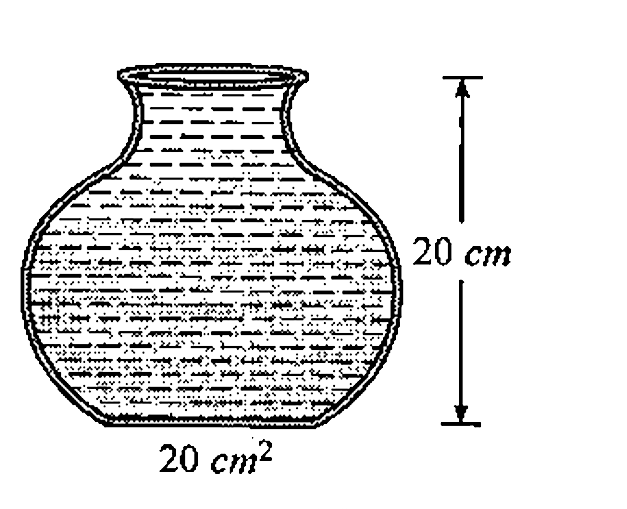Find the pressure exerted below a column of water, open to the atmosphere, at depth
(i) 10 m " " (ii) 30 m
(Given, density of water =1×103kgm−3,g=10ms−2)
To find the pressure exerted below a column of water at a given depth, we can use the hydrostatic pressure formula:
P=P0+ρgh
Where:
- P is the total pressure at depth,
- P0 is the atmospheric pressure (approximately 1.013×105Pa),
- ρ is the density of the fluid (for water, ρ=1×103kg/m3),
- g is the acceleration due to gravity (given as 10m/s2),
- h is the depth in meters.
1. Identify the values:
- P0=1.013×105Pa
- ρ=1×103kg/m3
- g=10m/s2
- h=10m
2. Substitute the values into the formula:
P=P0+ρgh
P=1.013×105+(1×103)(10)(10)
3. Calculate the hydrostatic pressure:
P=1.013×105+1×103×10×10
P=1.013×105+1×105
P=2.013×105Pa
4. Convert to atm (optional):
1atm≈1.013×105Pa
P≈2.013×1051.013×105≈1.986atm≈2atm
(ii) For depth h=30m:
1. Identify the values:
- P0=1.013×105Pa
- ρ=1×103kg/m3
- g=10m/s2
- h=30m
2. Substitute the values into the formula:
P=P0+ρgh
P=1.013×105+(1×103)(10)(30)
3. Calculate the hydrostatic pressure:
P=1.013×105+1×103×10×30
P=1.013×105+3×105
P=4.013×105Pa
4. Convert to atm (optional):
P≈4.013×1051.013×105≈3.96atm≈4atm
Final Answers:
- Pressure at 10 m depth: 2.013×105Pa or approximately 2atm
- Pressure at 30 m depth: 4.013×105Pa or approximately 4atm
- P is the total pressure at depth,
- P0 is the atmospheric pressure (approximately 1.013×105Pa),
- ρ is the density of the fluid (for water, ρ=1×103kg/m3),
- g is the acceleration due to gravity (given as 10m/s2),
- h is the depth in meters.
- P0=1.013×105Pa
- ρ=1×103kg/m3
- g=10m/s2
- h=10m
P=P0+ρgh
P=1.013×105+(1×103)(10)(10)
P=1.013×105+1×103×10×10
P=1.013×105+1×105
P=2.013×105Pa
1atm≈1.013×105Pa
P≈2.013×1051.013×105≈1.986atm≈2atm
- P0=1.013×105Pa
- ρ=1×103kg/m3
- g=10m/s2
- h=30m
P=P0+ρgh
P=1.013×105+(1×103)(10)(30)
P=1.013×105+1×103×10×30
P=1.013×105+3×105
P=4.013×105Pa
P≈4.013×1051.013×105≈3.96atm≈4atm
- Pressure at 10 m depth: 2.013×105Pa or approximately 2atm
- Pressure at 30 m depth: 4.013×105Pa or approximately 4atm
Topper's Solved these Questions
- BOOK - DC PANDEYCHAPTER - FLUID MECHANICSEXERCISE - Example 13.51videos
FLUID MECHANICS
- BOOK - DC PANDEYCHAPTER - FLUID MECHANICSEXERCISE - Example 13.61videos
FLUID MECHANICS
- BOOK - DC PANDEYCHAPTER - FLUID MECHANICSEXERCISE - Example 13.31videos
FLUID MECHANICS
- BOOK - DC PANDEYCHAPTER - EXPERIMENTSEXERCISE - Subjective15videos
EXPERIMENTS
- BOOK - DC PANDEYCHAPTER - GENERAL PHYSICSEXERCISE - INTEGER_TYPE2videos
GENERAL PHYSICS
Similar Questions
Find the pressure exerted below a column of water, open to the atmosphere, at depth
(i) 5 m
(ii) 20 m
(Given, density of water = 1×103kg m−3,g=10ms−2)View SolutionThe pressure acting on a submarine is 3×105 at a certain depth. If the depth is doubled the percentage increase in the pressure acting on the submarine would be :
(Assume that atmospheric pressure is 1×105 Pa density of water is 103kgm−3,g−10ms−2)View Solution
Knowledge Check
- Question 1 - Select One
The guage pressure exerted below a column of water, open to the earth's atmosphere at depth of 10 m is (density of water = 1000 kg/m3, g = 10 m/s2 and 1 atm pressure = 105 Pa)
A1 atmB2 atmC3 atmD4 atm - Question 2 - Select One
The pressure at a point in water is 10 N/m2. The depth below this point where the pressure becomes double is (Given density of water = 103 kg m−3, g = 10 m s−2)
A1 mmB1 cmC1 mD10 cm - Question 3 - Select One
A body is experiencing an atmospheric pressure of 1.01×105N/m2 on the surface of a pond. The body will experience double of the previous pressure if it is brought to a depth of (given density of pond water =1.03×103kg/m2, g=10m/s2)
A8mB8.6mC9.7mD10.3m
Calculate the total pressure at the bottom of a lake of depth 5.1 m (atm pressure =105 P), density of water =103kg/m3,g=10m/s2
View SolutionA glass full of water has a bottom of area 20cm2, top of area 20cm, height 20cm and volume half a litre.

a. Find the force exerted by the water on the bottom.
b. Considering the equilibrium of the v, after. find the resultant force exerted by the side, of the glass on the water. Atmospheric pressure =1.0×105N/m2. Density of water =1000kg/m−3 and g=10m/s2View SolutionA vessel full of water has a bottom of area 20cm2, top of area 20cm2, height 20 cm and volume half a litre as shown in figure.
(a) find the force exerted by the water on the bottom.

(b) considering the equilibrium of the water, find the resultant force exerted by the sides of the glass vessel on the water. atmospheric pressure =1.0×105N/m2. density of water =1000kg/m3 and g=10m/s2View SolutionAt a depth of 500 m in an ocean what is the absolute pressure? Given that the density of seawater is 1.03×103kgm−3 and g=10ms2
View SolutionA body is experiencing an atmospheric pressure of 1.01×105N/m2 on the surface of a pound . The body will experience double of the previous pressure if it is brought to a depth of (given density of pound water =1.03×103kg/m2,g=10m/s2 )
View Solution

